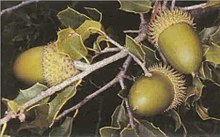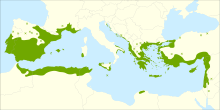Kermes Oak
| Kermes oak | |
|---|---|
 |
|
| Scientific classification | |
| Kingdom: | Plantae |
| (unranked): | Angiosperms |
| (unranked): | Eudicots |
| (unranked): | Rosids |
| Order: | Fagales |
| Family: | Fagaceae |
| Genus: | Quercus |
| Section: | Cerris |
| Species: | Q. coccifera |
| Binomial name | |
|
Quercus coccifera L. |
|
 |
|
| Distribution map | |
| Synonyms | |
|
List
|
|
Quercus coccifera, the kermes oak, is an oak in the Quercus section Cerris. It is native to the Mediterranean region and Northern African Maghreb, south to north from Morocco to France and west to east from Portugal to Cyprus and Turkey, crossing Spain, Italy, Libya, Balkans, and Greece, including Crete. The Kermes Oak was historically important as the food plant of the Kermes scale insect, from which a red dye called crimson was obtained. The etymology of the specific name 'coccifera' is related to the production of red cochineal (crimson) dye and derived from Latin coccum which was from Greek κὀκκος, the kermes insect. The Latin -fera means 'bearer'.
Quercus coccifera is usually a shrub less 2 metres (6.6 ft) tall, rarely a small tree, reaching 1–6 metres (3.3–19.7 ft) tall (a 10 metres (33 ft) specimen recorded in Kouf, Libya) and 50 cm trunk diameter. It is evergreen, with spiny-serrated coriaceous leaves 1.5–4 cm long and 1–3 cm broad. The acorns are 2–3 cm long and 1.5–2 cm diameter when mature about 18 months after pollination. They are held in a cup covered in dense, elongated, reflexed scales.
Leaves of Quercus coccifera
Leaves of Quercus coccifera
The kermes oak, Quercus coccifera is a closely related to the Palestine oak (Quercus calliprinos) of the eastern Mediterranean, with some botanists including the latter in kermes oak as a subspecies or variety. The Palestine oak is distinguished from it by its larger size (more often a tree, up to 18 m) and larger acorns over 2 cm diameter.
...
Wikipedia
